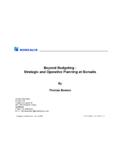Transcription of Beyond Detention - UNHCR
1 Beyond DetentionA global strategy to support governments to end the Detention of asylum-seekers and refugeesUNITED NATIONS HIGH COMMISSIONER FOR REFUGEES2014-2019 Division of International ProtectionUnited Nations High Commissioner for RefugeesCase Postale 25001211 Geneva 2, SwitzerlandTel: +41 22 739 8433 Fax: +41 22 739 7344internet: electronic version of this strategy is available at: Hard copies can be obtained by contacting the Protection Policy and Legal Advice Section in the Division of International Protection, Geneva Photo UNHCR / G. Kotschy Back Cover Photo UNHCR / V. Tan UNHCR 2014, Revision 1 Layout: BakOS DESIGNC ontentsWhy is a global strategy needed? ..5 What main challenges and concerns are addressed by the global strategy ? ..6 What are the 3 main goals of the global strategy ? ..7 What needs to be done to achieve the global goals? ..7 The initial roll-out June 2014 - June 2016.
2 8 Developing national action plans ..9 1 Problem analysis and diagnosis ..9 2 Advocacy interventions ..10 3 Awareness raising and campaigning ..11 4 Securing access to and monitoring places of immigration Detention ..12 5 Providing/strengthening technical knowledge, cooperation and capacity-building for all stakeholders (including training) ..13 6 Strengthening partnerships ..14 7 Promoting information sharing, data collection and reporting ..14 8 Investing in, carrying out and disseminating research ..15 9 Allocating and leveraging resources ..16 Monitoring and evaluation ..16 Achieving the goals ..17 Goal 1: End the Detention of children ..17 Goal 2: Ensure that alternatives to Detention are available in law and implemented in Goal 3: Ensure that conditions of Detention , where Detention is necessary and unavoidable, meet international standards ..20 Annex: Existing tools and materials.
3 22 page 3 UNHCR page 4 Beyoned DtnDiAGdldbiGyaSdriDiaDgyadsupvlsupm UNHCR / M. Edstr mWhy is a global strategy needed?Putting people in Detention has become a routine rather than exceptional response to the irregular entry or stay of asylum-seekers and migrants1 in a number of countries. Some governments view Detention as a means to dissuade irregular migration to or applying for asylum in their territories. While acknowledging that irregular entry or stay may present many challenges to States, Detention is not the in fact shows that not even the most stringent Detention policies deter irregular migration, and further, that there are workable alternatives to Detention that can achieve governmental objectives of security, public order and the efficient processing of asylum ap-plications. Importantly, as seeking asylum is not an unlawful act, detaining asylum-seekers for the sole reason of having entered without prior authorisation runs counter to international law.
4 Under international law, individuals have the right to seek asylum, and if they do so, to be treated humanely and with dignity. Access to open reception arrangements and fair and efficient status determination procedures need to be part of the overall State also has many negative lasting effects on individuals. It undermines their human dignity and can cause unnecessary suffering, with serious consequences for their health and wellbeing, in particular when they are detained for long periods. Detention increases anxiety, fear and frustrations and can exacerbate past traumatic experiences. It takes place, frequently, in places and in conditions that do not meet human rights standards. Detention of children is particularly serious due to the devastating effect it may have on their physical, emotional and psychological development, even if they are not separated from their families.
5 Children should, in principle, not be detained at removes asylum-seekers from the community, which is sometimes the goal, inhib-iting opportunities to benefit from existing support networks (both formal and informal), and diminishing people s capacity to be independent, self-sufficient and fulfilled members of the community after release. All these factors are further aggravated by the uncertainty about its duration and view of the hardship which it entails, and consistent with international refugee and human rights law, the Detention of asylum-seekers should normally be avoided and be a measure of last s global strategy Beyond Detention 2014-2019 aims to make the Detention of asylum-seekers an exceptional rather than routine Persons detained in places of immigration Detention may include refugees, asylum-seekers, rejected asylum-seekers, stateless persons, trafficked persons, or irregular migrants.
6 While the mandate of UNHCR covers only some of these categories, it is important that Offices understand the broader migration context. Likewise, action taken on behalf of persons of concern to UNHCR may also bring positive benefits for migrants, and as far as possible a joined-up approach with relevant actors would be recommended. See, Note on the Mandate of the High Commissioner for Refugees and his Office, October 2013, available at: See UNHCR , Guidelines on the Applicable Criteria and Standards relating to the Detention of Asylum-Seekers and Alternatives to Detention ( UNHCR , Detention Guidelines), 2012, paragraph 14, available at: page 5 BeyonWhat main challenges and concerns are addressed by the global strategy ?The global strategy will work towards addressing some of the main challenges and con-cerns around governmental Detention policies and practices, including: Misconceptions about Detention , its role and function.
7 Lack of information regarding the availability, the types and effectiveness of alternatives to Detention . The increasing rate and use of Detention in a number of countries and/or its automaticity. Detention is assumed as the default position in immigration laws and State practice. The use of Detention as a deterrent. Not only does Detention not work as a deterrent, it is not a legitimate purpose for Detention under international law. The lack of reliable statistics about the number and length of time persons are held in immigration Detention , at both national and global The limited access (in some countries) to places of immigration Detention and limited capacity to carry out systematic monitoring of these places of Detention by UNHCR and/or its partners. The often precarious and substandard conditions of Detention , including for persons with special needs or in situation of Conditions of Detention must be humane and dignified.
8 UNHCR / S. Baldwinpage 6 global strategy - Beyond Detention 2014-2019 What needs to be done to achieve the global goals?To achieve each of the global goals, UNHCR offices, together with their partners, are to de-velop and implement Plans of Action, at the country and/or regional level, as appropriate. Such action plans may contain the following elements: problem analysis and diagnosis advocacy interventions awareness raising and campaigning securing access to and monitoring places of immigration Detention providing/strengthening technical knowledge, cooperation and capacity building for all stakeholders strengthening partnerships promoting information sharing, data collection and reporting investing in, carrying out and disseminating research allocating and leveraging resources monitoring and evaluationWhat are the 3 main goals of the global strategy ?
9 Working with governments and other partners, the three main global goals are to:1 end the Detention of children;52 ensure that alternatives to Detention are available in law and implemented in practice;3 ensure that conditions of Detention , where Detention is necessary and unavoidable, meet international standards by, inter alia, securing access to places of immigration Detention for UNHCR and/or its partners and carrying out regular each of these main goals may require a set of objectives or sub-goals developed at the national level in order to set in place the foundation for further The global strategy also acknowledges that there may be different, or additional, goals to be pursued in particular countries or regions, which can be incorporated into national plans of This limitation is not just related to lack of access to appropriate national records by UNHCR but specifically by the lack of reliable and updated statistics produced, shared and/or made public by States.
10 Where immigration Detention statistics are available, they may not be disaggregated by those of concern to UNHCR . Further, the way in which States calculate the length of Detention varies considerably, making comparisons over time or between countries See UNHCR , Detention Guidelines 8 and In pursuing this goal it is important for Offices and partners to take account of UNHCR s Framework for the Protection of Children, 26 June 2012, available at: See, Achieving the goals in this document. page 7 UNHCR UNHCR / A. Di LoretoThe initial roll-out June 2014 - June 2016 The initial roll-out of the global strategy will be focused in the coming two years on 10+ fo-cus countries, selected on the basis of a range of criteria, including regional and thematic diversity, size and significance of the problem, likelihood of making an impact in the initial roll-out period (albeit without prejudicing long-term impacts), as well as staffing and resourc-es.
















